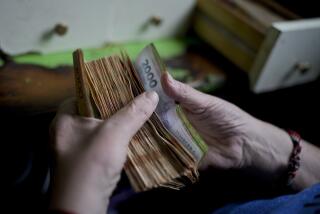New Pesos Introduced in Mexico : Currency: Starting today, an old 1,000-peso bill is worth 1 new peso, but both are still valued at about 33 cents.
- Share via
MEXICO CITY — Americans headed to the border this New Year’s weekend are in for a surprise: The money has changed.
A new peso--representing the government’s decision to drop three zeros from the currency--debuts today. What was once 1,000 pesos (worth about 33 cents) is now a single peso (still about 33 cents).
Dropping the zeros is supposed to be the coup de grace for the hyperinflation of the 1980s that drove the peso’s value from 12 per dollar down to 3,000 per dollar. After a decade-long struggle, Mexico has reduced inflation to about 12% a year from a peak of 159%, and the new peso is to symbolize the nation’s return to a solid currency.
The new currency will also make bookkeeping simpler.
Appearing today are new bills, such as a 100-peso note to replace the 100,000-peso bill, and new coins in denominations from 1 to 5 pesos, as well as a 50-centavo piece (half a peso), which has been out of circulation for years.
The bills look much like the old currency--with three fewer zeros--but the new coins bear designs of the Aztec calendar, instead of the faces of national heroes on the old coins.
Central bank officials have distributed 500 billion pesos of the new currency--about $167 billion--to banks in recent weeks. However, the old money will still be accepted for an indefinite period while the new currency is put into circulation.
Mexico has been preparing for the change for months. Since September, supermarkets, restaurants and other businesses have quoted prices in both old and new pesos to get people used to the idea. Credit card slips have also required totals in both currencies.
However, this week some Mexicans still expressed skepticism and confusion about the change.
“People are going to be afraid and they won’t spend money,” predicted 35-year-old restaurant kitchen helper Eustoria Hernandez as she shopped at the downtown San Juan Market. “The prices are the same, but that will not be the perception.”
Indeed, 72-year-old housewife Mercedes Rosales said, “A person really does not know how to adapt to these changes. The fast-talkers are going to end up with all our grocery money.”
Both women were shopping for fruit at Humberto Alvarez’s stall. In business barely a month, the 23-year-old greengrocer had all his prices clearly marked in both old and new pesos to reassure customers.
“It’s going to be easy once people get used to it,” the young entrepreneur said.
Antonia Valdez, 58, who has worked at her family’s vegetable stall at the Cuauhtemoc Market for 50 years, is not reassured.
“People are going to come back from the holidays and they will have to deal with this new currency,” she said. “There will be a lot of confusion.”
Since the value of the currency has not changed, “from an economic point of view, the change is completely neutral,” said Alberto Gomez Alcala, an analyst at the Banacci financial group.
More to Read
Sign up for Essential California
The most important California stories and recommendations in your inbox every morning.
You may occasionally receive promotional content from the Los Angeles Times.










